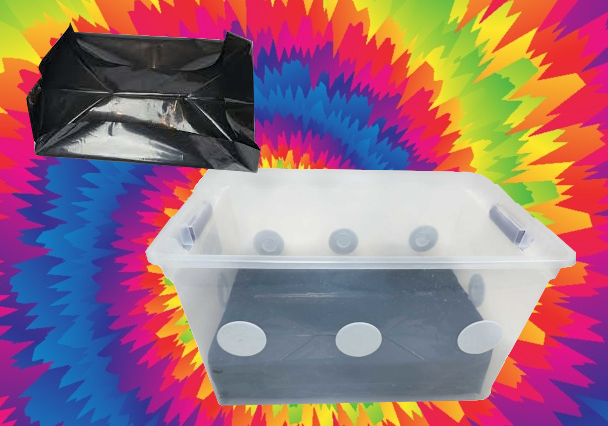Lifestyle & Culture, Link in Bio
Why You Shouldn’t Put Liners Inside Monotubs
What’s a Liner and Why are They Used
There are many variations in monotub setup but most will agree the bottom portion of a tub needs to be covered/light proofed. This is because light impacts the direction that mushrooms will grow in, similar to plants. Although it is true that mushrooms are not photosynthetic, meaning they don’t need light to grow, they are still photosensitive, meaning they are still responsive to light.
For example, if you take a white flower, place it in a vase with water and give it some light it will grow and remain white. But if you add blue food coloring to the water in the vase the white flower will begin to take up the food coloring and grow blue. It doesn’t need the blue food coloring to grow but it still responds to the blue food coloring by slowly turning blue.
Back to mushrooms now… We light proof the bottom portion of the monotub to prevent the bulk substrate from receiving light. If it were to receive light then mushrooms would start to grow beneath the surface where they would be difficult to harvest, resulting in a waste of nutrients, materials and time.
A very common method for light proofing the bottom of a monotub is with a liner. Most are diy and made out of a folded up plastic liner or garbage bag while others are professionally made and more rigid. But placing either inside the tub can potentially create problems.
As we know, monotubs must be 100% sterile. Any form of contamination can mean the entire tub is wasted, along with its contents and months of precious time. Sure, adding a liner to the inside can be done successfully but the reality is when you do this you’re now introducing an additional item inside the monotub; an additional item that can be or become contaminated. And since most are made with folds, this is also an additional item that can harbour excess moisture, one of bacteria’s best friends. Even when properly sterilized, adding a liner is a risk and arguably unnecessary considering the other options available.
Other Options
- If you MUST use a liner, adding one to the outside of the tub would be far less risky. There would also be more materials you could use such as aluminum foil or duct tape, neither of which should be used on the inside. Using an external liner is one less item inside the tub that you need to worry about and would also save on time and cost by not having to produce a new one every time you start a new run.
- Another option would be spray paint. Flat black would be best but any color can work as long as it’s applied thick enough to prevent light from entering. One small catch with this option is that paint doesn’t bond well to plastic.If you wanted to be as thorough as possible you could start by applying a primer first. A primer would create a better surface for your paint to bond to. Another step you could take to create a nice, durable coat would be to wait for the paint to dry and then go over it with a coat of polycrylic or polyurethane. This would protect the paint from chips and scratches as the monotub gets shifted or dragged around.Flex Seal is even a viable option here.
- There are monotubs that are sold already having a light proof bottom portion. They also come in kits with everything else you would need like holes on the sides along with plugs and filters for those holes. You’ll need each throughout different phases of the growth process.
Final Thoughts
The point is keeping as many elements as possible outside of the tub creates a much better environment for your mycelium and mushrooms to thrive in. You’ll still find people who swear by the internal liner and will refuse to give it up. That’s ok, again there are years of successes with it. Unfortunately, you will also find countless examples of how liners inside the tub have lead to complications.
Sterilization technique is still of the utmost importance here. You can flawlessly use an internal liner. You can also still mess up with an external liner. It will ultimately come down to what’s best for you. Consider things like cost, material availability and time investment. Also feel free to experiment with different methods to determine your best way forward. By now you can probably tell where we stand on the matter but that’s just us, comment below with your experiences and thoughts.
Products Mentioned
- Primer → Buy on Amazon
- Spray Paint → Buy on Amazon
- Polycrylic → Buy on Amazon
- Flex Seal → Buy on Amazon
- Monotub → Buy on Amazon

